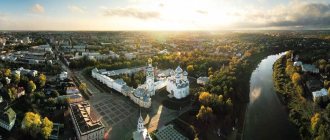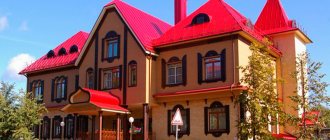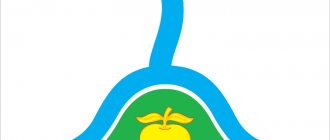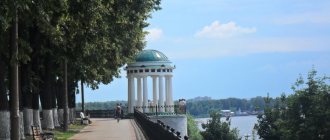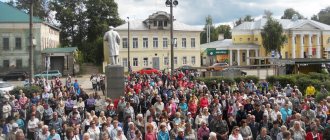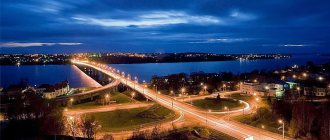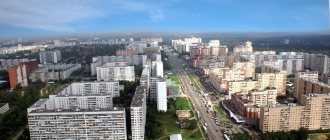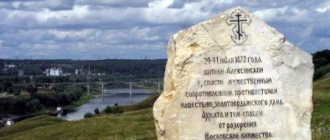Kaliningrad is the capital of the region
As of 2022, the population of Kaliningrad is approaching 480 thousand. The city's natural growth rate is high; there are many families with two or three children. In addition to Russians, Belarusians, Ukrainians, Armenians and Lithuanians live here. Traffic jams are rare in Kaliningrad. The city's transport accessibility is great; many minibuses can take you to your destination without any problems. There are enough kindergartens and schools for everything. There is a regional hospital with a diagnostic center.
The city is experiencing many infrastructure problems. But all of them are associated with the unscrupulous approach of utility services, which keep high tariffs, but are in no hurry to provide the proper level of service. Kaliningrad has a difficult situation with traffic intensity. It can be compared to the traffic of densely populated million-plus cities. Even though Kaliningrad is considered a large city relative to the entire region, its residents themselves never cease to be amazed at how many cars have increased in recent years. There are few transport links, so congestion may become even worse in the coming years. For now, they only bother Kaliningrad residents in the early morning and evening, when everyone is trying to get to work or home. The most difficult situation is observed on Moskovsky Prospekt. It is noteworthy that specialized transport, called “railbuses,” contributes to traffic jams. More precisely, the problem lies in the paths.
Kaliningrad has enough educational institutions. Students come here to further transfer to foreign universities. Kaliningrad residents can get not only an education in their city, but also good work experience.
Our move from Siberia to the Kaliningrad region (Sovetsk)
Hi all!
I would like to finally share my story of moving, the first in my adult and conscious life.
I arrived in Omsk in 2007, right after graduating from school, and I vaguely remember exactly how the move went. My classmate, who also decided to enroll in an Omsk university, and I bought tickets, and for the first time, I rode the train myself, without my parents. I don’t remember how I transported things.
But I remember in detail the move I organized from Omsk to the Kaliningrad region, the city of Sovetsk. The idea of moving initially came not from me, but from my boyfriend (at that time we were not married). He applied that he would like to transfer, and almost 9 months later he received a call saying that he was expected to be hired.
Sovetsk: Victory Square, tram car - mini-museum
We started preparing for the move about 4 months in advance, when we were informed that we needed to collect documents. I read reviews from those who moved, found out about sending things, renting housing, tickets for us, and also found out the nuances of traveling for a cat. Thanks to various forums and sites, including this one, we have decided on the main issues.
Firstly, we decided to fly by plane, since traveling by train takes a very long time. I periodically monitored the cost, and in the end we bought two Aeroflot plane tickets with a transfer in Moscow for 18,740 rubles.
Secondly, I learned that in order for a cat to fly away with us, a number of conditions must be met:
- the cat has an international passport;
- availability of necessary vaccinations against rabies, received no later than 20 days before the date of the planned flight;
- obtain a veterinary certificate of the established form, which is issued only by state veterinary clinics, and valid for 5 days from the date of issue;
- the presence of a carrier with a hard bottom, having dimensions not exceeding the permissible ones;
- separate paid ticket. At Aeroflot it costs 50 euros, and is paid directly during registration.
In order for the cat to be able to fly with us in the cabin, we must make a request to the airline in advance. If permission is not given, then the cat flies in a special compartment of the luggage compartment. The cost of the ticket is not affected by whether the animal flies on board or in luggage.
Thirdly, we decided on the method of transporting things. We chose the PEC company because many people mentioned this company in their reviews, and the majority were satisfied with the services provided. Whoever sent it basically knows the order. Let me just say that oral consultations with company specialists turned out to be pointless. I incorrectly told them the dimensions of things, and accordingly they told me the wrong amounts. When we took the things to the warehouse and completed all the paperwork, we were told the true dimensions and amount - 9 pieces, 95 kg, 0.98 m3 (1.27 m3 with rigid packaging), 5,500 rubles with delivery to Sovetsk.
Cathedral of the Three Saints in Sovetsk
Fourthly, we found housing. We searched through Avito. We chose it based on the photo, found the owner, made an advance payment and were calm.
We have lived in Sovetsk for a little over a year. I didn’t apply for a job, so there’s not much to say about employment. But! I periodically looked through vacancies on the relevant websites - I didn’t find anything in my specialty (law), in the local newspaper - for the whole year I saw the required advertisement once. Based on the feedback from local residents, I realized that if you have connections and acquaintances, it’s easier to get a job.
In the park
The climate suits me. I've never been sick here. But during my trips to Omsk throughout the year, I was sick on each of them. During the rains, which don’t happen so often here, there’s often just drizzle, a little puddles and mud. Last winter there was practically no snow. It fell out 6 times, of which 2-3 times it stayed for a couple of days before melting. For me, a winter without snow was a shock))) Everything begins to turn green and bloom early, and this beauty lasts until October. In October, all the leaves begin to turn yellow, fly off, and it becomes very gray and dull outside.
Square
Prices for food and related products, it seems to me, are generally the same as in Omsk. Some things are really more expensive, some things are cheaper. Thanks to changes in the dollar and euro exchange rates in the winter of last year, they, of course, rose sharply. Over the course of the year, I noticed that prices were “jumping”, but this was apparently some kind of marketing trick.
On the shelves you can see goods from Poland and Lithuania; they were a novelty for us, of course, when we moved, but now the eye has become accustomed to it and is not surprised. On New Year's holidays, we sent parcels to family and friends with “overseas” sweets so that they could try them too.
Entrance to the city park
We did not deal with the issue of buying a home, only renting. On average, a 1-room apartment, furnished and in good condition, costs 5,000 rubles per month. 2-room – already 7000-9000 rubles. It's more expensive in Kaliningrad. Utility bills are higher than in Omsk. Every month we give receipts to the owner of the apartment so that she pays; I have no information about the tariffs.
View of the courtyard where we rent an apartment
According to the tariffs, for 2 people with registration a communal apartment in the summer would cost about 2500-3000 rubles, in the winter 3500-4000 rubles. If you need more precision, I can add the data for this month later.
It seems to me that everyone needs to visit the Kaliningrad region at least once. There is history in every building, incredibly beautiful nature!
Military registration and enlistment office building
Our Sovetsk is small in area, with a population of 43,000, and is the second largest city in the region after Kaliningrad. There are no large shopping centers or hypermarkets here. Shops are mainly on the first floors of houses. After a city of millions, this is surprising)
Victory Square - the building of the Palace of Culture, the city administration, the monument to V.I. Lenin. The pedestrian street starts from this place
For unassuming people, the assortment is sufficient; the rest go shopping to Kaliningrad, Poland. There is a large market, and small retail outlets where older people lay out their goods - food, clothing, books, and so on.
A lot of greenery! There is a large park with a monument to Queen Louise, a small pond with ducks and benches to sit, relax and enjoy nature.
Monument to Queen Louise
There is a large city lake where you can feed not only ducks, but also swans.
View of the city lake
Old German houses are in a shabby state, but some are being restored little by little. Five- and nine-story block buildings also want renovation, and many have posters pasted on them saying they are next in line.
The old lyceum building, now there is an elementary school there, as I understand it
The roads are narrow for my taste. A lot of paving stones. There are few pedestrian crossings, which is also for my taste. There are only 3 traffic lights in the whole city, not a single one works) The route is, of course, gorgeous!
Paving stones
There are shuttle buses running around Sovetsk, but I don’t know how much it costs. I walk, sometimes by taxi. For me, everything here is within walking distance! Yes, and breathing unpolluted air is worth a lot. Taxi in the main part of the city costs 50 rubles, in remote areas 80 rubles.
An express train departs from the bus station every half hour to Kaliningrad, the ticket costs 220 rubles, the journey takes approximately 1 hour 45 minutes. There is also a railway station, but I didn’t find out where you can go from there, I heard that trains go to Kaliningrad.
One of the few traffic lights) never works
There is also nothing to say about schools and kindergartens - there are no children, but it seems to me that there are enough kindergartens! There is a lyceum, a gymnasium, and schools.
New registry office building, previously the department was located in the administration
I had a chance to go to a hospital, namely a clinic. The audience, like everywhere else, are pensioners. Thank God, my husband found a good, sane therapist. I went to paid clinics, the cost of ultrasound and initial appointments was less than in Omsk.
Children's park
Over the course of a year, we got used to the terrain, the climate, the situation, and life in a calm and quiet town, but Sovetsk never became ours, our hometown, where we would want to take root.
Baltiysk is a city with specific problems
Little Baltiysk is far from the problems of large cities, but it has its own that can surprise the average resident of a million-plus population. Despite their small numbers, they often face a shortage of affordable housing. Old wooden dilapidated houses freeze in winter. Finding good housing for everyone is impossible. The infrastructure problems of Baltiysk concern the old water supply system, which is confined to the German system of the century before last. People complain about the water being of disgusting quality and having a rusty color. Of course, this does not apply to everyone, but rather to commuters.
There are few kindergartens; none have been built in the last three decades; the queue of applicants is so long that it can drag on for 5-10 years. Approximately 150 children per year can “enter” kindergartens, and there are already more than 1,500 applicants. But there are also very positive aspects regarding children. Sports facilities have been built for them where they can practice rowing. One such school is located on the Baltic Spit. There are no well-paid jobs here. The population is trying to go to Kaliningrad to earn money. They also go there for medical help, since Baltiysk cannot yet have a high level of medical care.
Chernyakhovsk is a small city with a lot of problems
Even though the population of Chernyakhovsk is small, the population is familiar with demographic problems firsthand. As of 2018, the city, according to the residents themselves, is in decline. Many factories and enterprises have gone bankrupt, so people simply have nowhere to work. The life of Chernyakhovsk is supported by a railway junction; internal communication between districts is provided by buses.
A positive trend is observed in the field of education. The city has enough schools and various institutions intended for children. There are also many public organizations here that offer various kinds of hobby clubs. However, in recent years there has been a steady outflow of numbers.
Famous people[edit]
Max von Schenkendorff
Frank Wisbar 1959
John Kay
- Daniel Klein (1609–1666), Lithuanian pastor and grammarian
- Johann Christian Jacobi (1719–1784), German oboist
- Max von Schenckendorff (1783–1817), German poet and writer.
- Franz Meyen (1804–1840), German botanist
- Hans Victor von Unruh (1806–1886), German politician and technician
- Wilhelm Voigt (1849–1922), inspiration for "Captain Köpenick"
- Margarete Poehlmann (1856–1923), German educator and politician, first woman to speak in the Prussian parliament.
- Gustav Kosinna or Kosina (1858–1931), archaeologist
- Johanna Wolf (1858–1943), German writer
- Max Shervinsky (1859–1909), German-born architect who worked primarily in Riga, Latvia.
- Emil Wichert (1861–1928), German geophysicist
- Raphael Friedeberg (1863–1940), German physician and politician.
- Max Gülstorff (1882–1947), German actor
- Karl Brinkmann (1885–1954), German sociologist and economist
- Franz Scheydy (1890–1942) Wehrmacht general during World War II.
- Walter Weiss (1890–1967), German general during World War II.
- Friedrich Schröder Sonnenstern (1892–1982), illustrator
- Dick Shikat (1897–1968) German professional wrestler and world heavyweight champion
- Frank Wisbahr (1899–1967) German director
- Karl Hermann Martell (1906–1966), German actor
- Franz Abromeit (1907–1964), SS officer, Reichssicherheitshauptamt ( Judenreferent
) - Joachim Sadrosinski (1907–1944), officer and resistance fighter.
- Erna Dorn (1911–1953) victim of injustice in the GDR.
- Siegfried Gratchus (1916–1943), SS Oberscharführer, killed during the uprising at the Sobibor extermination camp.
- Johannes Bobrowski (1917–1965), German writer
- Werner Abrolat (1924–1997), German actor
- Günter Wyshetzky (1925–1985), German-Canadian physicist
- Armin Müller-Stahl (born 1930), German actor, honorary citizen since 8 December 2011.[16]
- Sabine Bethmann (born 1931), German actress
- Jürgen Kurbühn (1940–2014), football player
- Klaus-Dieter Zieloff (1942–2011), football player
- John Kay (born 1944), lead singer of the late 1960s rock band Steppenwolf
- Edgar Frese (1944–2015), German founder and leader of the electronic music group Tangerine Dream
- Victor Ivriy (born 1949) Soviet, Canadian mathematician
- Andrei Sosnitsky (born 1962) Belarusian professional football coach and former player
Sovetsk is a city with developed infrastructure
The municipalities took care of the city streets. The population often notes that the roads in their yards are so beautiful that they surpass the landscaping of the yards in many large settlements. Accordingly, Sovetsk is great for walking. The mayor's office is making plans to pave the way for new streets.
Sovetsk has municipal preschool institutions and one kindergarten. The latter fact is overshadowed by the fact that people have to wait a long time to place their child.
For some period there were difficulties with healthcare. However, the national project “Health” made it possible to prevent diseases and successfully treat patients. This has reduced the number of cases associated with premature deaths. Currently, there are three treatment and prevention centers operating on the territory of Sovetsk:
- city Hospital;
- infectious diseases department;
- dentistry.
The city hospital has inpatient and emergency services, as well as a children's clinic. It is not always possible to serve all patients in a timely manner, but the municipal sector includes approximately 700 specialists with medical education. Ambulance transport, a laboratory complex, and various equipment are also provided. Sovetsk is distinguished by a large number of sports and fitness centers, but many of them do not have modern equipment. As a result, there is everything necessary for active sports, but there is simply no one to work with the population. The townspeople are trying to cope with the problem on their own.
Gusev - industrial city
Gusev does not have significant problems with overcrowding, and many specialists come here, since the Technopolis project has been created on the territory. As part of the project, television set-top boxes and receiver housings are created, and since 2012, a microelectronics development center has been in operation.
The result of the situation with the population of the Kaliningrad region is quite obvious. In many cities the number is small, but the small number of preschool institutions has a negative impact on the lives of many families. Also, people are faced with insufficient quality medical care, for which they go to the capital, which inevitably creates long queues.
Population[edit]
According to State Statistics Committee data as of January 1, 2022, 7,440 people live in Sovetsk. Sovetsk is the most sparsely populated city in the Tula region after Chekalin.
The male population, according to the 2010 All-Russian Population Census, is 43.7%, the female population is 56.3%.
| Year | Population | Year | Population | Year | Population | Year | Population | Year | Population |
| 1959 | 10 099 | 1970 | 11 024 | 1979 | 10 432 | 1989 | 10 077 | 1996 | 9800 |
| Year | Population | Year | Population | Year | Population | Year | Population | Year | Population |
| 1998 | 9500 | 2000 | 9100 | 2001 | 8800 | 2002 | 8770 | 2005 | 8400 |
| Year | Population | Year | Population | Year | Population | Year | Population | Year | Population |
| 2006 | 8100 | 2007 | 7900 | 2008 | 7700 | 2010 | 7536 | 2011 | 7500 |
| Year | Population | Year | Population | Year | Population | Year | Population | Year | Population |
| 2012 | 7442 | 2013 | 7452 | 2014 | 7363 | 2015 | 7347 | 2016 | 7360 |
| Year | Population | ||||||||
| 2017 | 7440 |
